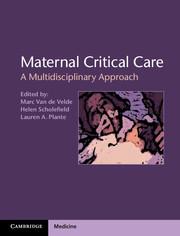
- Cited by 3
-
Cited byCrossref Citations
This Book has been cited by the following publications. This list is generated based on data provided by Crossref.
Lapinsky, Stephen E 2017. Maternal critical care. Obstetric Medicine, Vol. 10, Issue. 2, p. 51.
Phillips, Sioned and Schroeder, Frank 2019. Obstetric Anesthesiology. p. 268.
Kareem, Ozaifa Nisar, Sobia Tanvir, Masood Muzaffer, Umar and Bader, G. N. 2023. Thiamine deficiency in pregnancy and lactation: implications and present perspectives. Frontiers in Nutrition, Vol. 10, Issue. ,
- Publisher:
- Cambridge University Press
- Online publication date:
- July 2013
- Print publication year:
- 2013
- Online ISBN:
- 9781139088084


